Are you an adventurist looking to include a Montana deer hunting expedition in your action-packed travel list? Get to experience the exhilarating hunt for Montana’s mule deer and white-tailed deer, both famous for their adaptability and widely distributed across the state.
But now, do you know what your hunting experience requires? Beyond the thrill of the chase, this article is here to guide you on every aspect you’d need to know — from the natural habitats and food habits of these two elusive species to the essential deer hunting tips and tricks you might need.
We’ll also explain Montana FWP-issued hunting licenses fee structure, and introduce you to some of the best outfitters in the state. Plus, don’t worry if you struggle keeping up with your kids, who are as eager to hunt as you are. We’ll dig into the details of the Montana Youth Deer Hunt, an event specifically designed to get them started on this incredible opportunity.
- Related article: Hunting Tips for Montana
We’re going to cover all key aspects, so prepare to absorb the facts and tips that’ll make your hunting trip successful and a memorable experience in the sweeping landscapes of Montana.
7 Key Takeaways on Montana Deer Hunting
- Montana offers diverse deer species such as mule deer and white-tailed deer, each with unique characteristics and habitats.
- Conservation efforts make it vital for hunters to differentiate between species and understand hunting regulations.
- Deer ages can be estimated by examining their teeth, offering a unique perspective for hunters.
- The cost of deer hunting licenses varies for residents, non-residents, and young hunters.
- Licenses can be purchased in-store or online and include options like combination licenses for hunting and fishing.
- Montana Youth Deer Hunts are designed as a special 2-day event for young hunters, providing a safe and exciting environment to introduce children to the practice.
- Montana outfitters offer local expertise and ease of application process, maximizing your chances of a successful deer hunt with seasoned guides familiar with diverse landscapes.
What to Know About Deer in Montana
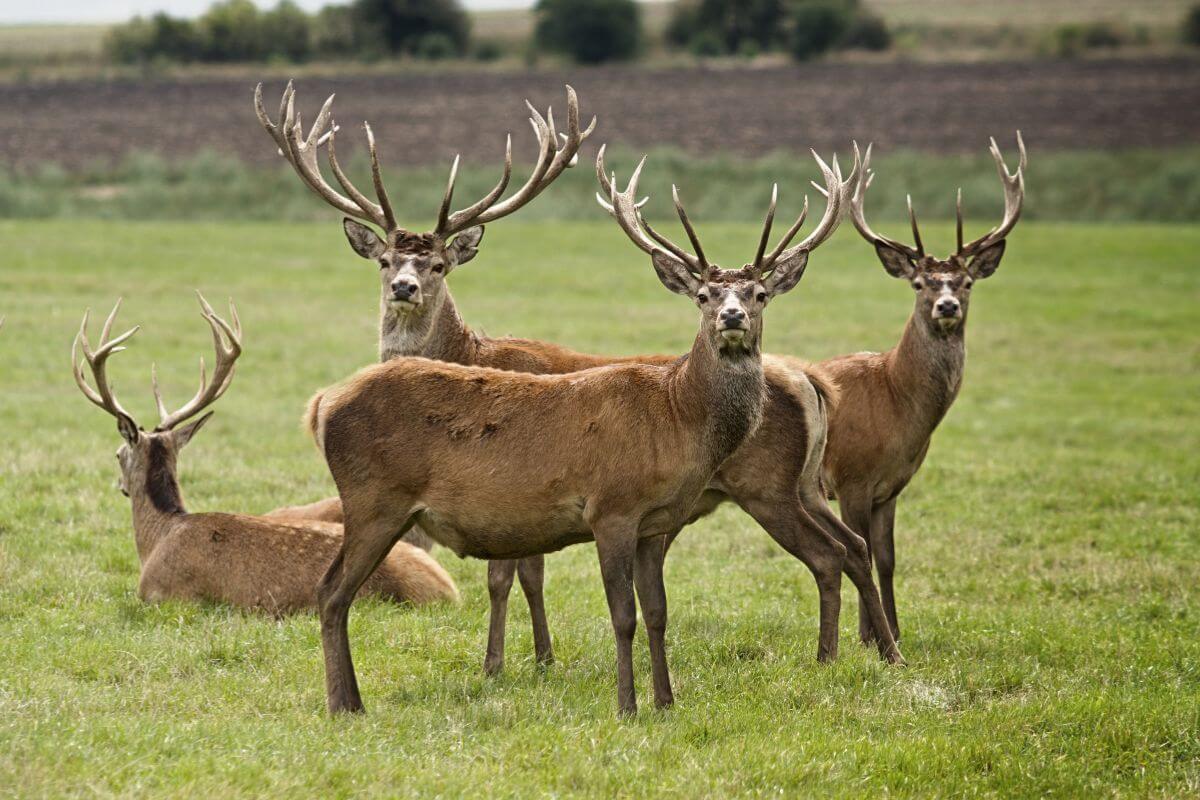
Like stars on canvas, Montana’s sprawling landscapes come alive during hunting season. The state’s deer population might be more camera-shy than its mountainous scenery, but that doesn’t mean it’s elusive.
In Montana, deer are managed as a big game species, with mule deer and white-tailed deer being the most widely distributed and abundant big game mammals in the state. Before you take that shot, it’s essential to learn more about deer in Montana.
Species of Deer in Montana
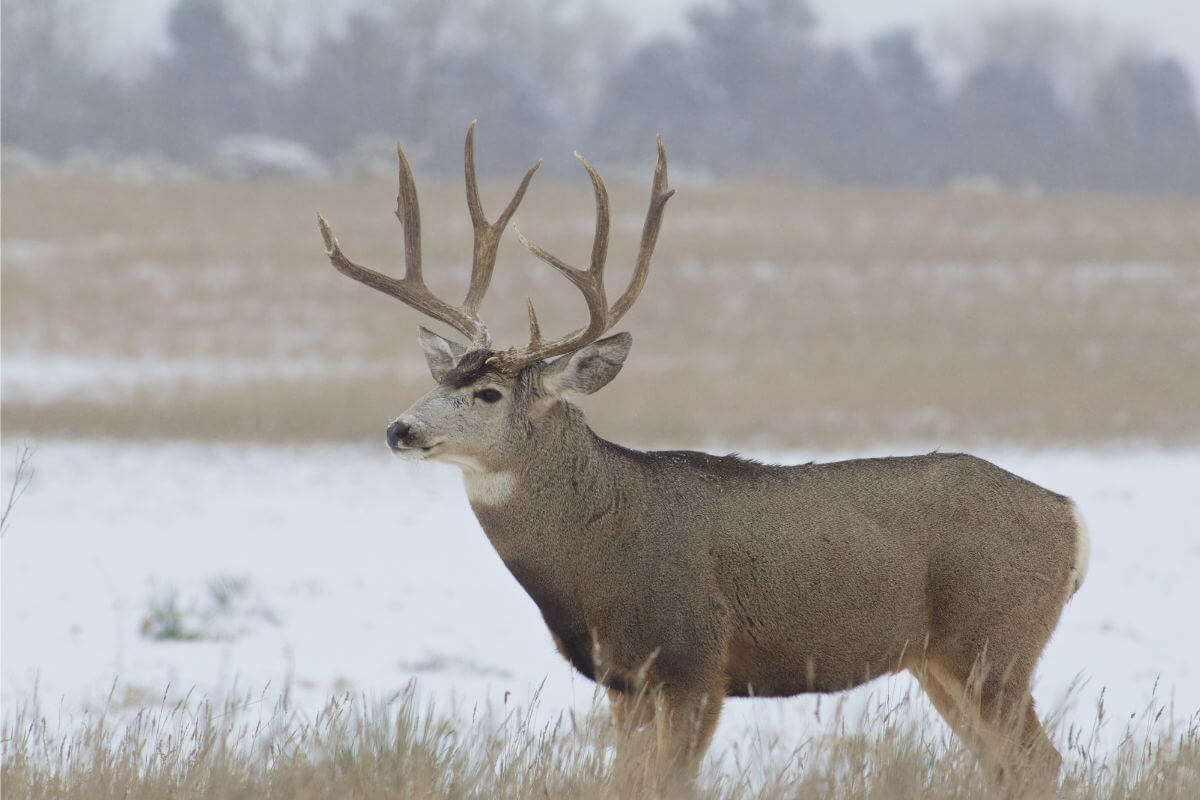
While mule deer and white-tailed deer evolved to live and thrive in different environments, they are remarkably adaptive and occur in a wide variety of habitats under widely fluctuating environmental conditions.
This adaptability has contributed to their wide distribution and abundance in Montana. Hunters and wildlife enthusiasts alike are drawn to the diverse landscapes of the state to engage with these majestic creatures.
Both mule and white-tailed deer species are classified as:
- Antlered Buck – A deer with an antler or antlers at least 4 inches long as measured from the top of the skull.
- Antlerless – A deer without antlers, or with antlers less than 4 inches long as measured from the top of the skull.
So, in what other ways are these species different? Let’s take a look at the chart below.
White-tailed Deer and Mule Deer Comparison Chart
| Attribute | White-tailed Deer | Mule Deer |
| Physical Characteristics | Older males have antlers with 3 to 5 upward tines. | Iconic antlers that fork and then fork again, especially in older males. |
| Ears are smaller in proportion to the head. | Large ears in proportion to the head. | |
| Erects its tail when threatened, revealing a distinctive all-white fringe. | Distinctive rope-like white tail with a black tip. | |
| Habitat | River and creek bottoms, and dense vegetation in higher altitudes. | Roam diverse landscapes from wooded foothills to open shrub-dominated slopes. |
| Open bitterbush hillsides in winter. | Adapt to grasslands, dense forests, and aspen groves. | |
| Food Habits | Munch on leaves, twigs, fruits, and berries of browse plants. | Prefer Bitterbush, Mountain Mahogany, and Chokecherry, along with grasses and forbs. |
| Graminoids (grasslike plants) are important in spring. | Diet shifts to shrub browse in fall, winter, and spring. | |
| Winter diet primarily consists of browse plants. | Grass is a minor diet item. | |
| Food habits can vary between years. |
So next time you’re planning a Montana hunt, don’t forget to add mule deer to your bucket list. Just be prepared for the chase; they’re as elusive and elegant as they come.
Deer Aging
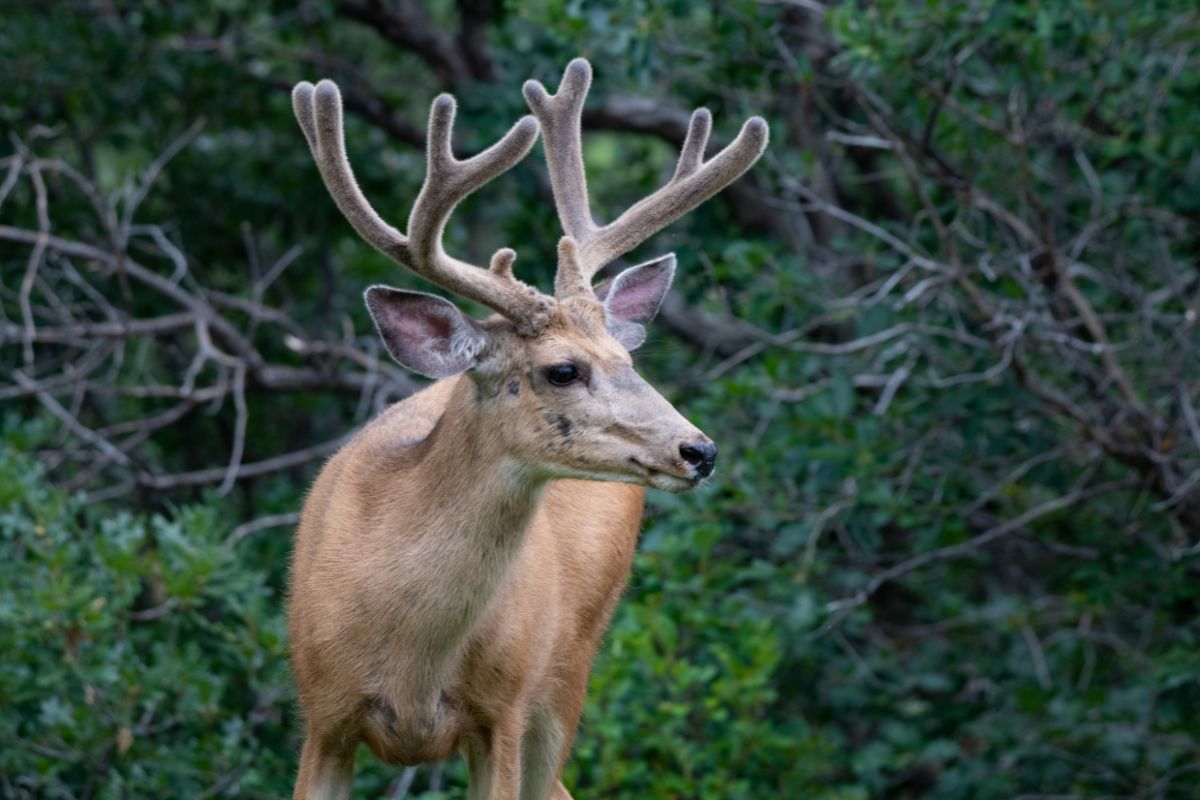
Deer carry secrets in their teeth – literally. Much like the annual rings of a tree, deer build a new layer called cementum on their incisors each year. This means you can estimate the age of the deer you take by looking at its pearly whites.
Here are the different age classifications for deer based on tooth wear:
- Fawn – A fawn’s smile comes with an incomplete set of teeth. The lower jaw boasts 3 premolars and 1 molar on each side.
- Yearling – A deer at 1.5 years old will have 3 poorly worn premolars, and a third premolar with 3 crowns, which you can think of as their baby teeth. These will be replaced next summer.
- 2-Year-Old – At 2.5 years old, a deer will have a full set of permanent teeth. These teeth look spotless, with sharp, almost pointy crowns and minimal wear.
- Mature Deer – From 3 to 7 years, these teeth will show various degrees of wear, allowing you to further pinpoint their age. The lower jaw will contain a total of 20 teeth – 8 incisors, 6 premolars, and 6 molars.
- Mature Old Class – A deer classed as “mature-old” or 8 years and over will likely show teeth worn down to almost flat, sometimes nearly reaching the gums.
Experts can study these dental patterns to give you an approximate age of your catch. But for the average hunter, a more straightforward approach is to evaluate the replacement and wear of teeth on the lower jaw.
Both mule deer and whitetails are fair game for this method. Simply slit the cheekbone to expose the teeth on the lower jaw for a closer analysis.
Montana Deer Hunting Licenses and Fees
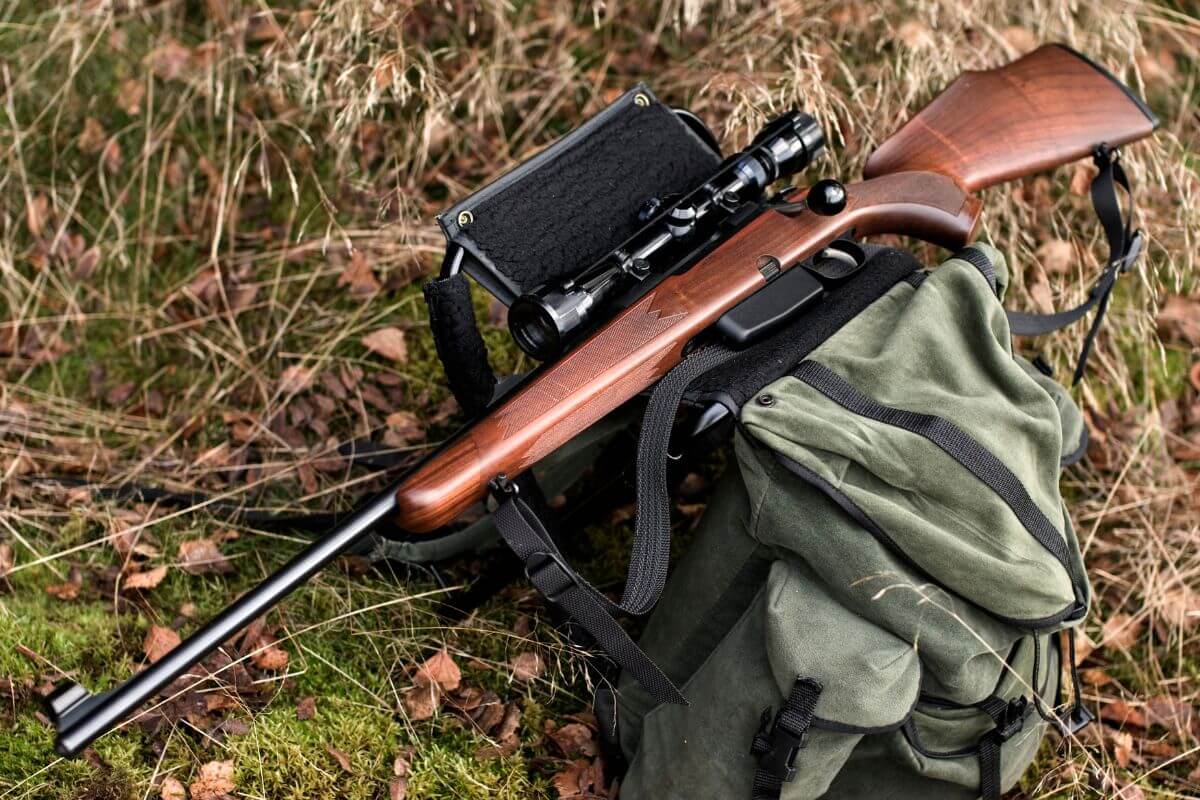
Whether on an expert-guided or self-guided mule deer hunt, one of the foremost things you’ll need for your escapade is the right license. But before you start envisioning dollar signs floating around your head, worry not, it’s not that costly to get started on your venison quest.
Types of Montana Deer Hunting Licenses:
1. General Deer License – This license is valid for one deer, available for residents over the counter and through a lottery drawing for nonresidents. Hunters can hold only one general deer license.
2. Deer B Drawing – The B License is an antlerless deer license valid for specific periods and hunting districts, with a non-refundable application fee of $5.
3. Deer B Over the Counter – Similar to B Drawing, this B license is available for specific periods and districts.
4. Deer B Antlerless Whitetail, Single Region – This allows the hunting of antlerless white-tailed deer in one region, with the hunter designating the region upon purchase. This license is not available for all regions.
5. Deer Permits – This permit extends hunting opportunities within specific districts, allowing some hunters to harvest a Buck Mule Deer. The permit must accompany a general deer hunting license and not grant the holder an extra kill.
Their Corresponding License Fees:
| Deer License/Permit | Availability | Deadline | Resident 18-61 years | Resident Youth (12-17) or Senior (62+) | Resident Disabled | Non-resident |
| General License | OTC | N/A | $16 | $8 | $8 | N/A |
| Deer Permit | Special Drawing | April 1 | $5 | $5 | $5 | $5 |
| Deer B License | Drawing | June 1 | $15 | $15 | $15 | $80 |
| Deer B License | OTC | N/A | $10 | $10 | $10 | $75 |
| Deer B — Antlerless Whitetail, Single Region | OTC | N/A | $10 | $10 | $10 | $75 |
Buying a deer license in Montana is as simple as walking into a store (or doing it online) and asking for one. The price won’t prick your wallet, especially if you’re a Montana resident. Non-resident costs can add up though, so plan accordingly.
Non-Resident Deer Hunting Licenses and Fees
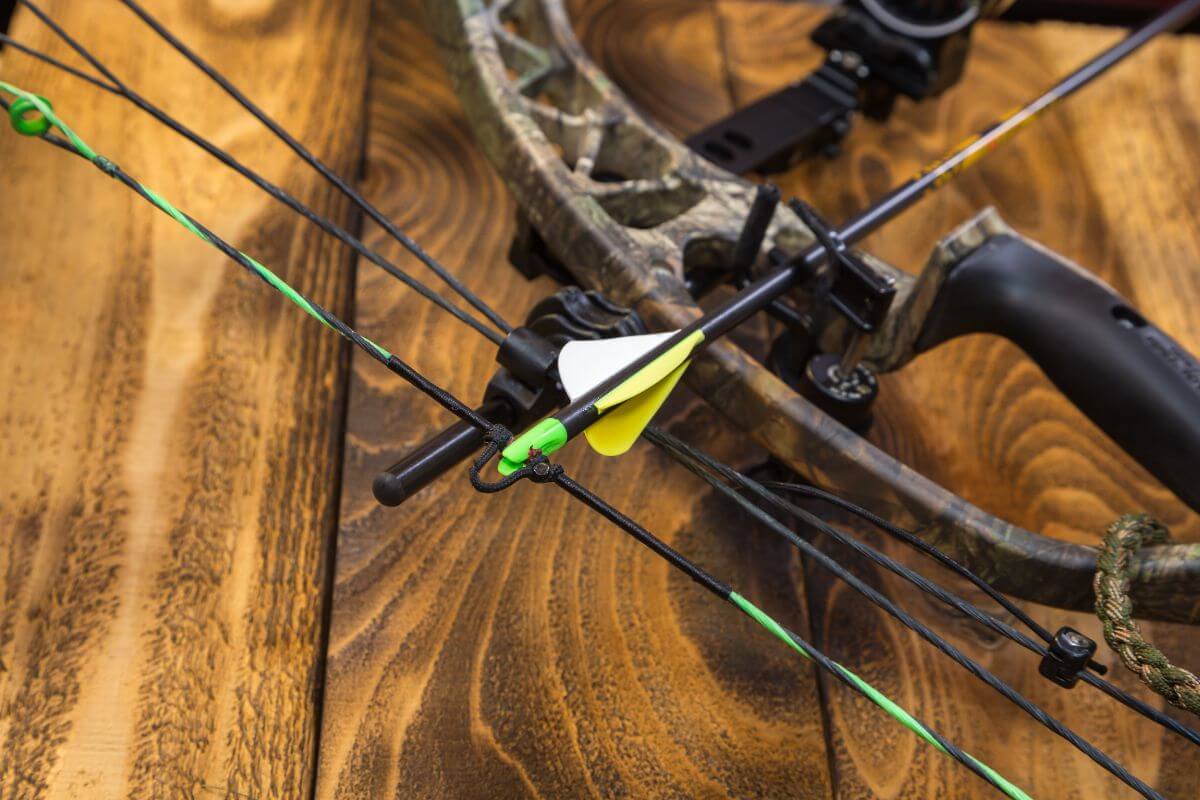
If you’re like me — a hunter whose love for Montana has outlasted their residency — the intricacies of non-resident hunting licenses may feel like puzzle pieces you’re trying to put together. Before you eagerly put that hunting crossbow to the test, hold your horses; there are important non-resident hunting licenses to learn about.
To give you a clear picture, let’s shed light on the different licenses available for non-residents, as served up by the Montana Fish, Wildlife & Parks (Montana FWP), and how you can get your hands on one:
- Deer Combination General – This is your all-access pass, bundling a General Deer license with the joy of fishing and upland game bird hunting (except for turkey). But here’s the hitch — it’s a once-a-year deal for non-residents.
- Deer Combination Landowner Sponsored – Similar to the General Deer combo, this requires you to cozy up to a landowner in Montana and hunt their grounds, and yes, it’s a once-a-year shot.
- Nonresident Montana Native Big Game & Deer Combination License – If you used to call Montana home and can rustle up current resident kin to vouch for you, there are specific native big game and deer licenses.
- Come Home to Hunt Big Game & Deer Combination – Even if you’ve moved on but want to make your hunting memories here, these combos, necessitating a sponsor who’s a Montana resident family member, give you the privilege to hunt elk and other game as well.
- Nonresident Student Hunting License – For non-resident college students with 12 credits or more at a Montana college or university, there’s a student hunting license inclusive of an AIS Prevention Pass and base hunting license.
Let’s shift gears now and talk figures. Below is a breakdown of the fees and availability for each type of non-resident hunting license:
| Deer Non-Resident License | Non-Resident Fee | Availability | Deadline |
| Deer Combination — General | $704 | Special Drawing | April 1 |
| Deer Combination — Landowner Sponsored | $704 | Special Drawing | April 1 |
| Nonresident Montana Native Big Game Combination License | $604 | OTC | N/A |
| Nonresident Montana Native Deer Combination License | $352 | OTC | N/A |
| Come Home to Hunt — Big Game Combination | $604 | Special Drawing | April 1 |
| Come Home to Hunt — Deer Combination | $352 | Special Drawing | April 1 |
| Nonresident Student Hunting License — Big Game Combination | $554 | OTC | N/A |
| Nonresident Student Hunting License — Deer Combination | $323 | OTC | N/A |
While the fees might seem a bit steep, remember that it’s about funding the incredible ecosystem that makes Montana such a prized location for hunters. Respecting this process only enhances our experience as we seek solace in the state’s natural playground.
Montana Youth Deer Hunt
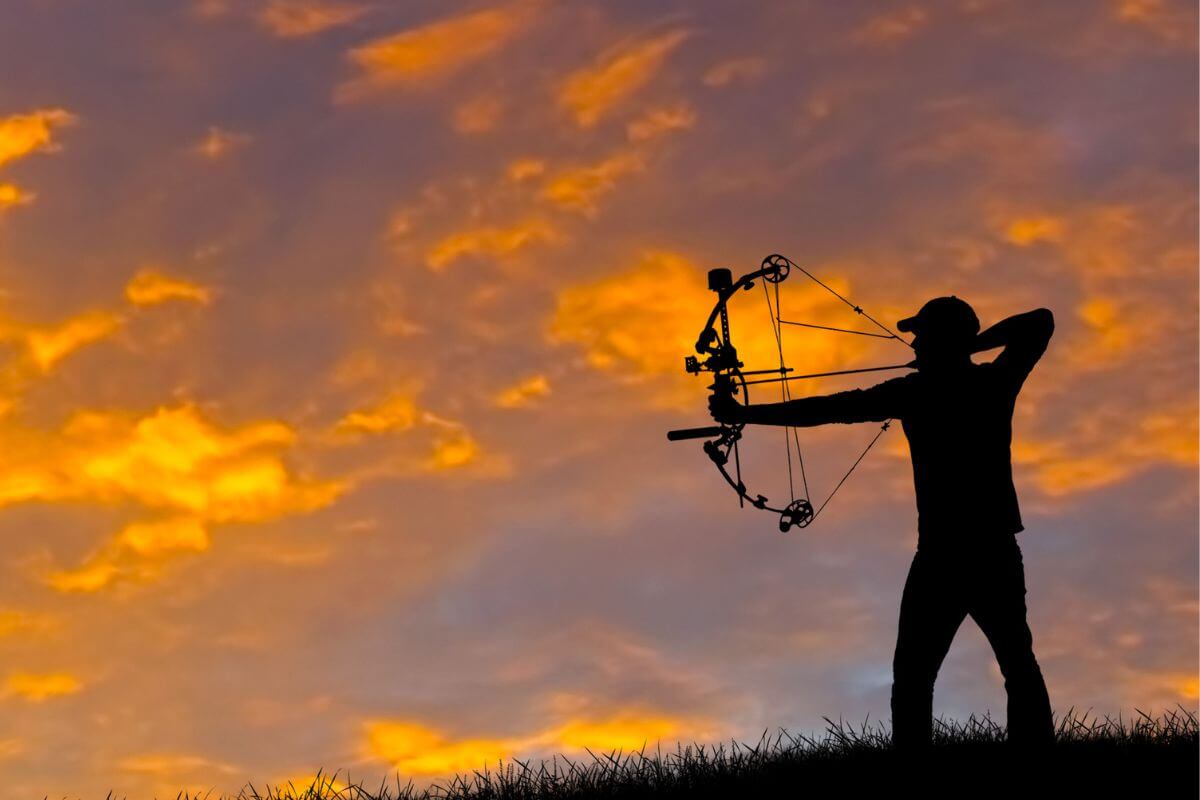
Are you looking for a chance to introduce your little adventurer to the timeless art of hunting? Your kids may have watched you expertly handle that bow and arrow over the years, wondering when it will be their turn.
Montana Youth Deer Hunt is an extraordinary opportunity carved in the hunting calendar, specially designed for young enthusiasts aged 10 to 15. Here’s a glimpse of what Montana has in store for its young hunters on these dates:
- The Special 2-day Youth Deer Hunt happens on October 17 and 28, 2024.
- Youth hunters and apprentice hunters aged 10-15 may hunt during the Youth Statewide Two-day Deer Hunt.
- During these two days, youth hunters can take deer species and sex otherwise available on their general deer, deer permit, or deer B license.
- An adult at least 18 years of age must accompany the youth hunter in the field.
- Shooting hours, hunter education requirements, and all other regulations that apply to the general deer firearm season apply to this youth two-day deer hunt.
To fully prepare, an important detail to note, an ‘apprentice hunter’ is a resident or non-resident certified individual at an FWP office.
As an experienced hunter, you’ll know just how crucial it is to instill a love for the outdoors and responsible hunting practices in the next generation. Getting your young one involved in the thrill of the hunt, under proper guidance and within a regulated environment, can create lasting memories and stronger bonds between mentor and student.
Montana Outfitters for Deer Hunting
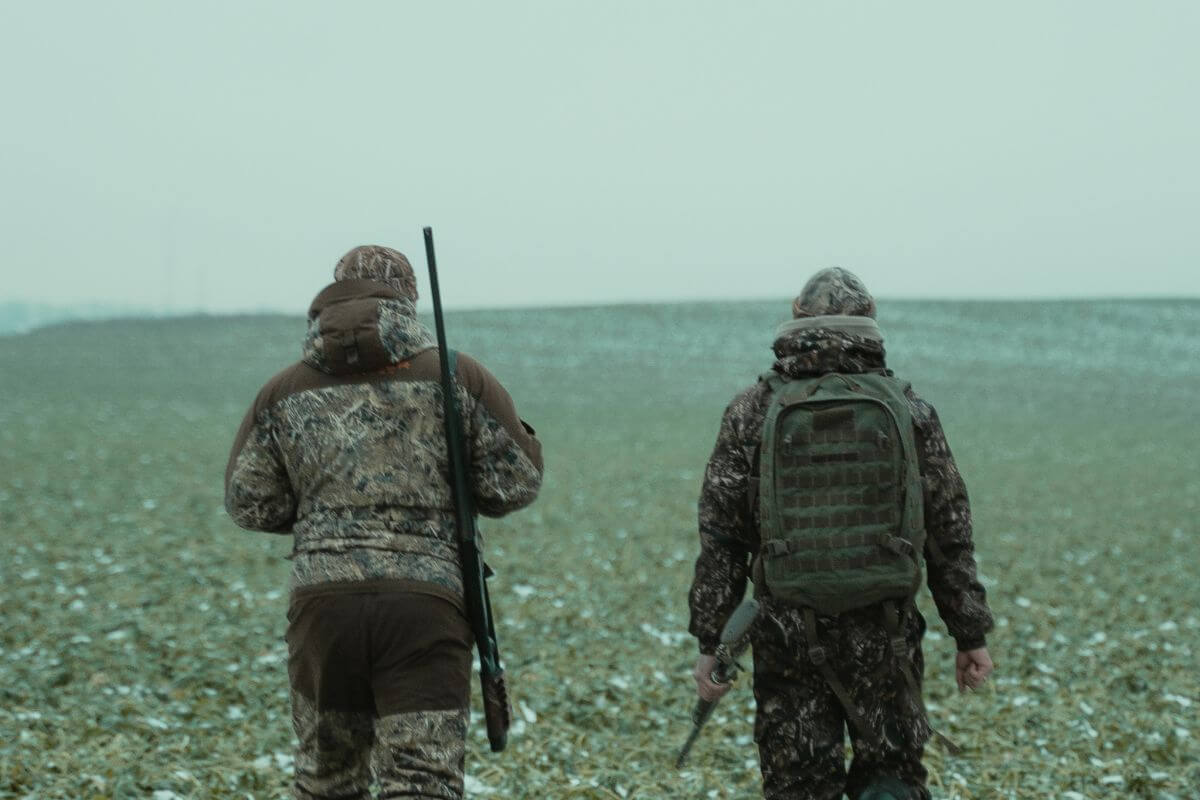
When tackling the vast Montana wilderness in pursuit of your venison dreams, having the right outfitter can make all the difference. These are folks who know the lay of the land, where the deer roam, and often have a whole lot of local knowledge to share.
Whether it’s the pursuit of trophy bucks or simply the thrill of the hunt, Montana outfitters offer unparalleled opportunities for deer hunting enthusiasts.
1. Montana Big Game Outfitters
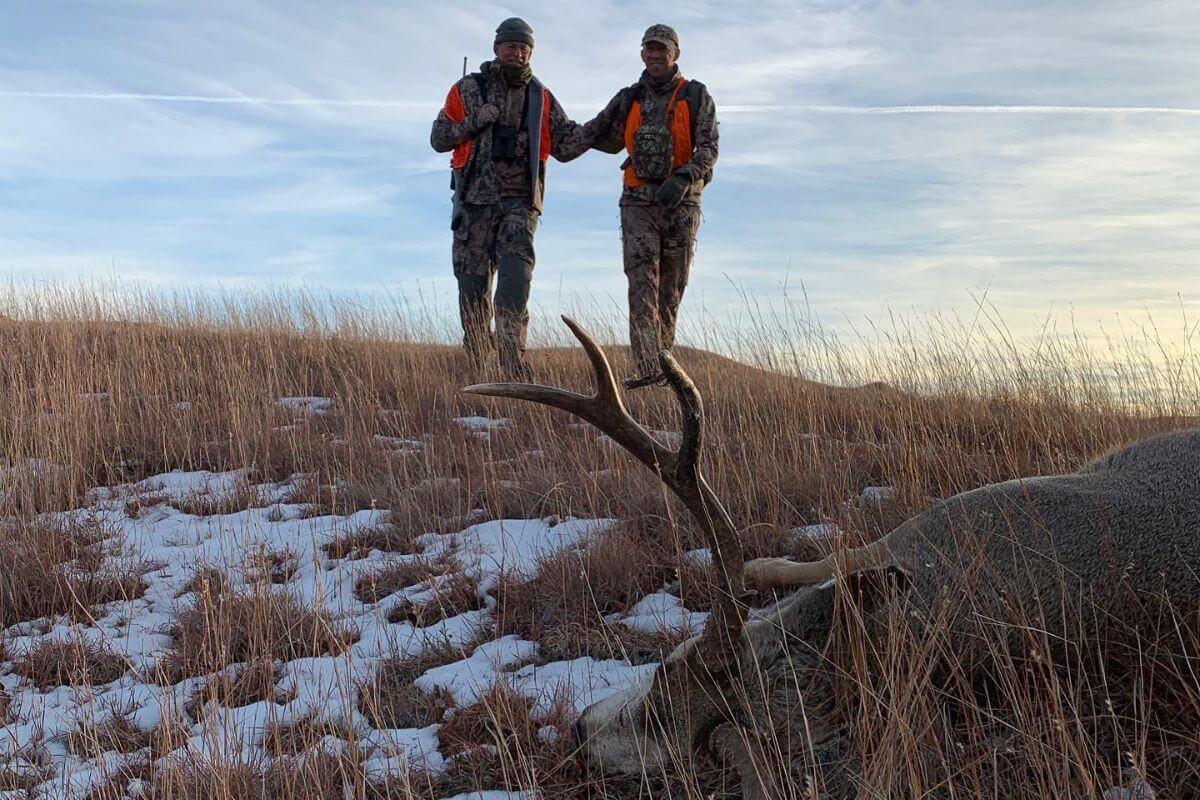
Located in the badlands of Eastern Montana, Montana Big Game Outfitters sets the gold standard for quality deer hunting. They not only provide an ideal mix of adventure and comfort but also deep expertise and a solid knack for customer satisfaction.
Touring their 100,000 acres of prime hunting land promises deer tales you’ll be boasting for years. What also makes Montana Big Game Outfitters stand out is the intimacy of their location – expect to be hiking into canyons that see as little human interference as your neighborhood’s new vegan burger joint.
If hiking isn’t your jam, no worries; they offer comfortable 4×4 vehicles to drive to advantageous vantage points. Plus, each day, you’ll be matched with an experienced guide who not only knows the land better but also infuses the hunts with their own quiet, confident charisma.
Particulars to look forward to in Montana Big Game Outfitters’ catalog include:
- Rifle Deer Hunts: Oct. 26 – Nov. 25 – This spot and stalk hunt sees an extraordinary 95% success rate on mature bucks. While not overly physically taxing, you’ll still get your exercise with some high-quality hikes.
- Archery Deer Hunts: Sep. 7 – Oct. 3 – If racking up a record mule deer using archery equipment is on your bucket list, you’ve come to the right place. This deer hunt creates opportunities that elevate your ultimatum skill levels.
So, unleash a cascade of quality deer hunting moments in Montana Big Game Outfitters’ vast natural landscape by following the experienced hunters’ footsteps.
2. Flatwillow Creek Outfitters
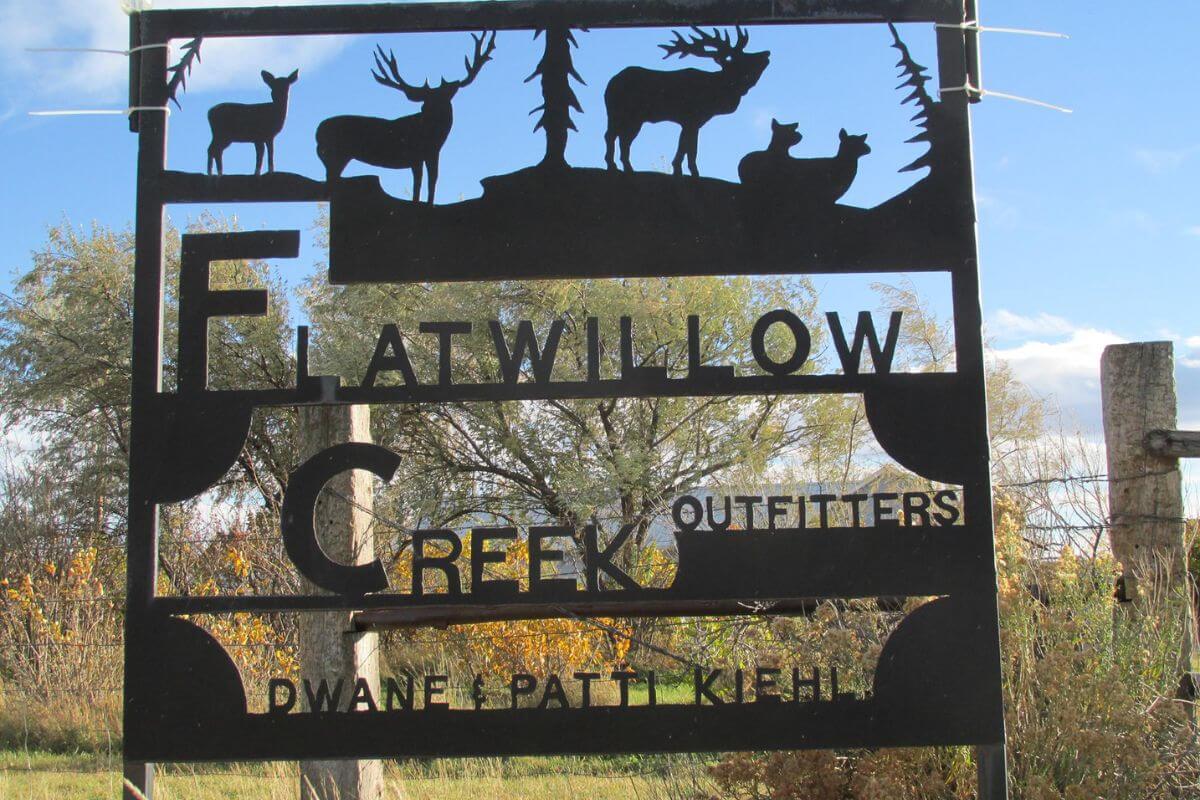
Flatwillow Creek Outfitters, located just about 100 miles (161 km) north of Billings, are your go-to folks if you’re in or around Big Sky Country. They’re pros at delivering top-notch Montana deer hunting expeditions.
What You Can Expect at Flatwillow Creek Outfitters:
- A Variety of Hunts – Flatwillow Creek Outfitters offers thrilling archery and rifle deer hunts, catering to both archery enthusiasts and traditional rifle-wielding hunters. Archery hunts span from September to early October, while the rifle season extends from mid-October to November.
- High Success Rates – High population density but you’d be lucky to see a single soul out hunting. Not here. The combo of Flatwillow’s game-rich venues and minimal hunting pressure means you’re highly likely to bag that prize buck you’ve been dreaming of.
- Quality Over Quantity – Their hunts for Montana’s “prince of the plains,” the mule deer, and the ever-sly whitetail deer, are conducted in private ranches thoughtfully managed to maximize wildlife health and, as a consequence, trophy quality.
With decades of experience under their belts, Flatwillow Creek Outfitters offers more than just a good hunting spot. From providing top-notch equipment to knowledgeable guides, you can trust them to make your Montana deer hunting experience both successful and enjoyable.
3. Swan Mountain Outfitters
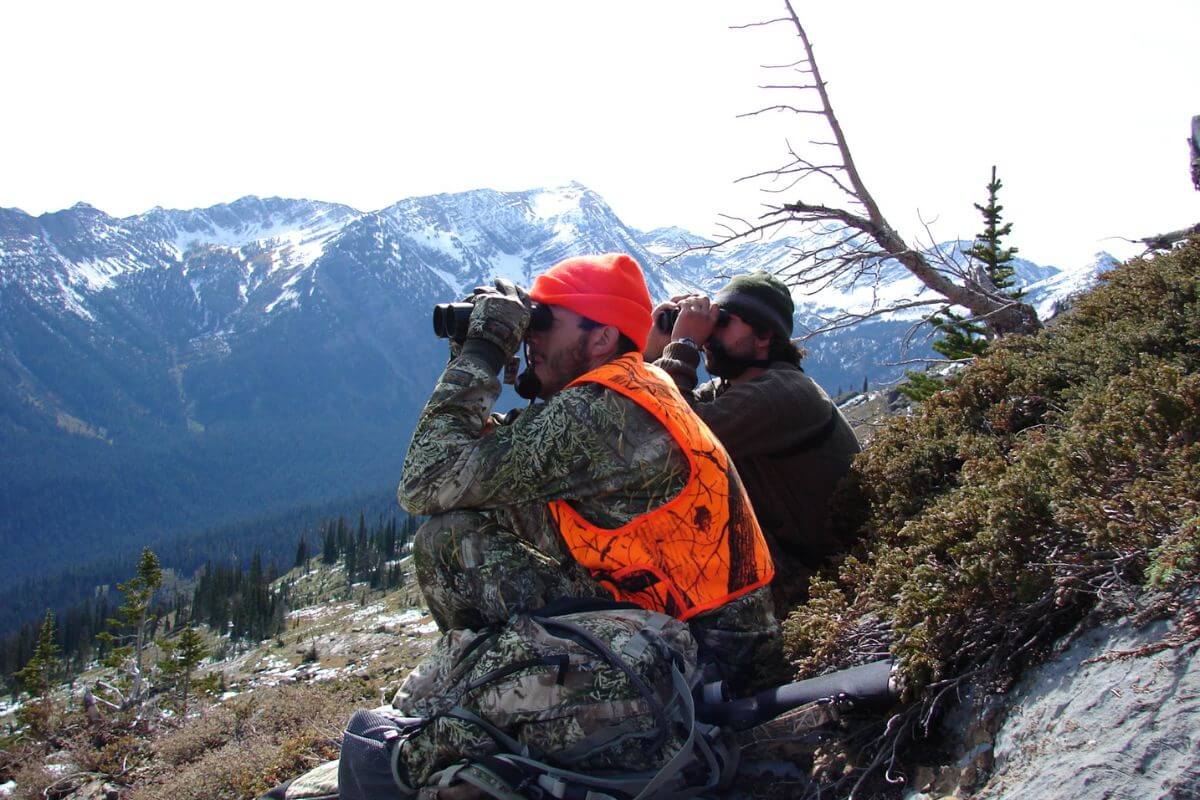
Swan Mountain Outfitters is your go-to outfitter if you’re eager to experience Montana’s deer hunting through a fresh lens. This operation doesn’t just offer your run-of-the-mill hunt; it’s designed for those who want to immerse themselves in the intricacies of whitetail deer hunting in the mountains.
Swan Mountain Outfitters specializes in mountain whitetails, found exclusively in the picturesque Flathead National Forest in Northwest Montana. The deer here aren’t overhunted, so they live longer and grow to impressive sizes.
Now, I’m not joking when I say they’ve tailored the experience for all types of hunters. Whether you want to take a shot using traditional stands and blinds or prefer to hunt whitetail deer by horseback, the options are as diverse as the forests you’ll be exploring.
It’s crucial to mention that Swan Mountain Outfitters operates exclusively on public land. This means they know these lands like the back of their hand. Hunting here is both ethical and legal, adhering to the highest conservation standards while still upping the excitement factor.
No matter how you choose to hunt with Swan Mountain Outfitters, you’re assured that your experience will be as unique as a set of antlers. The variety of options, the exclusive location, and the focus on mountain whitetails all combine to create something very special.
4. Montana Hunting Company
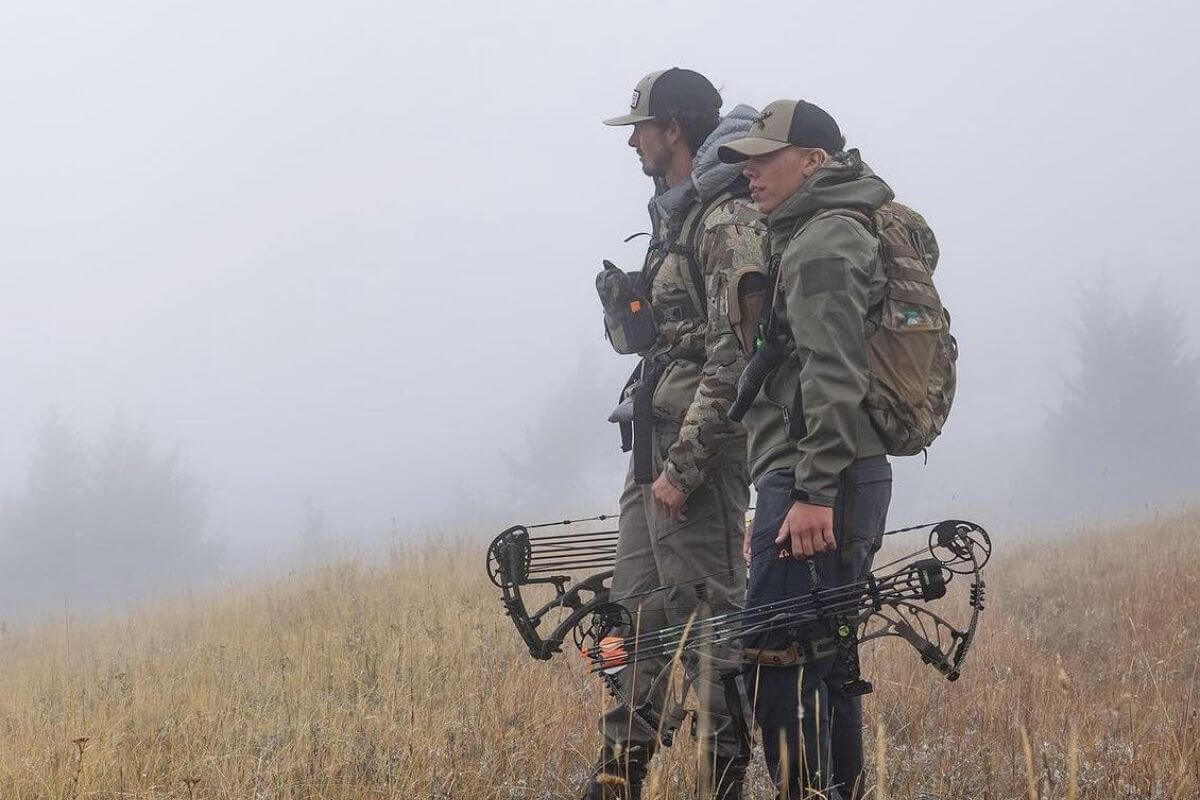
Montana Hunting Company is like that trusty old friend you can always count on. They’re driven by a commitment to excellence and grounded in the ethos of sound wildlife management. You see, their goal is not just to provide you with a memorable time but to ensure that Montana’s rich hunting heritage shines through every experience.
What You Can Expect from Montana Hunting Company:
- Rifle Mule Deer Hunts – They lead you into sprawling private ranches, creating the perfect conditions for quality trophy animals. You’ll feel like you’re in a hunting paradise, but with a conservation twist.
- Rifle Whitetail Hunts – These aren’t just your average whitetails; they’re Montana’s prized possessions. Managed for age and trophy quality, they have larger bucks, and the success rates are the envy of deer hunters everywhere.
But it’s not just about bagging the decent buck; their approach is steeped in respect for landowners, wildlife management, and of course, your satisfaction. If you’re after top-notch Montana deer hunting, whether with a hunting bow or a rifle, Montana Hunting Company has got you covered.
Montana Deer Hunting Tips
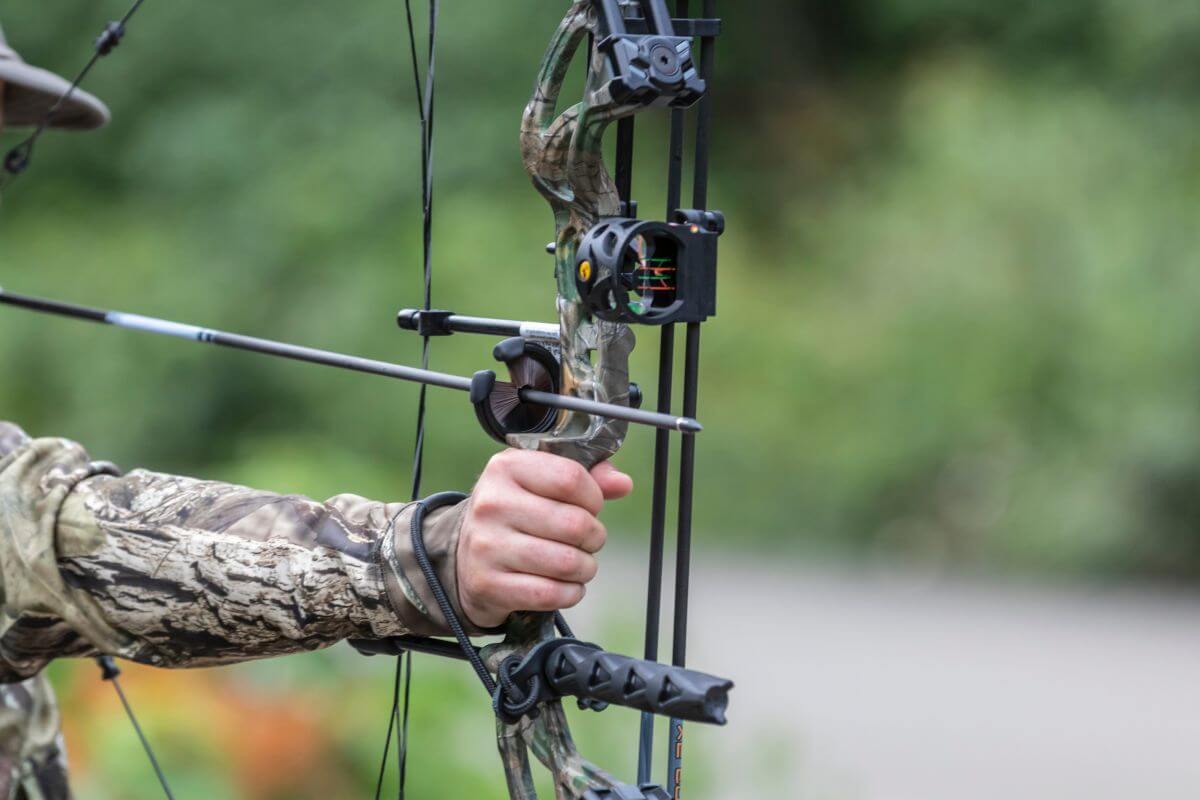
When it comes to hunting mule deer or whitetails in Montana, it’s a dance – a stealthy, surprising, natural boogie. Of course, this dance has its own set of rules, and you’ll want to be well-versed in them. Yes, that takes more than just knowing how to take prey down with a rifle or bow and arrow.
Here’s what you should have down if you want to waltz your way to a successful deer hunt:
- Ambush Hunting – For whitetail hunters in Montana, it’s a larger-than-life game of hide and seek with a significant prize. Using the classic ambush tactic, they target agricultural land, requiring patience, stillness, and a readiness to wait for the deer to approach.
- Cover Up Your Nose – Deer are a wily bunch with extremely keen senses. It’s entirely possible for a deer to sniff you out before you’ve even laid eyes on it. Specialist hunting gear can help mask your natural human odor, masking it effectively enough to outsmart these perceptive creatures.
- Use Trail Cameras – Essentially your eyes are in the woods 24/7, trail cameras are the ultimate scouting tool. By monitoring deer movement, you’ll be better positioned to choose your hunting spot, time, and approach.
- Mask Your Odor – An ingenious deterrent, particularly if you’re already well-concealed. Specialized scent-blocking sprays and even clothes can help you stay hidden.
- Establish a Call Strategy – The right call at the right time can be the deciding factor in luring deer in for a shot.
Here’s a look at the different call strategies and what each call indicates:
- Grunt – This is a call often used by dominant bucks and signals their power and presence.
- Rattle – Consider this like the sound at a boxing match – it indicates a more aggressive situation. Two bucks are likely fighting, so a rattlecall might set them off.
- Bleat – This mimics the call of a doe or fawn and can draw in a buck looking for company.
- Snort Wheeze – Expect this call from a big, dominant buck asserting its importance.
Remember, every hunting expedition is a learning experience. What works for you one day might not work the next, and that’s part of the fun and challenge of hunting.
Patience, an understanding of deer behavior and seasonal patterns, and a well-honed hunting skillset will all serve you well in the Montana wilderness. Good luck out there!
Montana Deer Hunting Final Thoughts
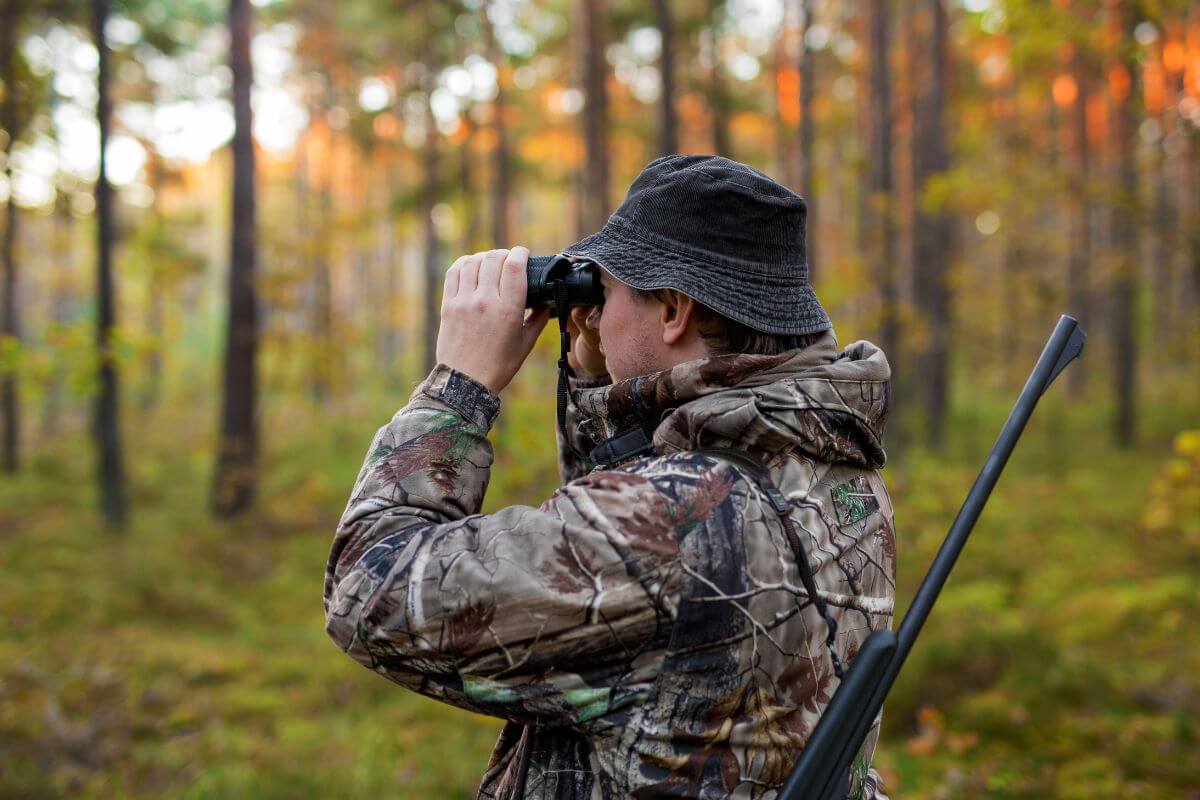
Montana, with its sprawling landscapes and rich deer population, sets the stage for exhilarating hunting experiences. By understanding the diverse deer species, spotting techniques, and hunting regulations, you’re not only enhancing your adventure but also contributing to Montana’s conservation efforts.
In the world of Montana deer hunting, patience is much more than a virtue, it’s the equivalent of your golden ticket. Whether you’re perched motionless in a tree stand or quietly waiting behind a shrub, remember that Montana’s deer are experts in their game as much as you are in yours.
Don’t rush, savor the experience. And if that perfect shot doesn’t come today, it’ll only make your next adventure more thrilling.
Every hunter has their “one that got away” tale; make sure yours is about the chase, not the lament. And with these insights, your Montana deer hunting trip is bound to become a legendary story in the making.
Montana Deer Hunting FAQs
1. Does Montana Have Good Deer Hunting?
Montana is known for its excellent deer hunting opportunities. The state offers diverse landscapes, including forests, mountains, and plains, providing habitats for both mule deer and white-tailed deer. Hunters often find success in Montana due to its abundant deer populations and well-managed hunting areas.
2. Where Is the Best Deer Hunting in Montana?
The best deer hunting in Montana is often found in regions such as the southwestern and eastern parts of the state, where a mix of public and private lands, along with varied terrain, provides optimal conditions for both mule deer and white-tailed deer hunting.
3. How Much Is a Guided Deer Hunt in Montana?
The cost of a guided deer hunt in Montana can vary widely depending on factors such as the duration of the hunt, the type of accommodations provided, and the reputation of the outfitter.
On average, guided deer hunts in Montana can range from $3,000 to $7,000 or more, with some premium hunts exceeding this range.
4. Are There Big Deer in Montana?
Montana is home to both mule deer and white-tailed deer, and the state is known for producing big and impressive specimens of both species. Hunters often have the opportunity to pursue trophy-sized deer in various regions of Montana due to its diverse landscapes and healthy deer populations.
5. Can a Nonresident Buy a Deer Tag in Montana?
Nonresidents can obtain a General Deer license in Montana, through the purchase of either a Deer or Big Game Combination license. This approach allows nonresident hunters to participate in deer hunting activities within the state.
Interested to learn more about Montana? The articles below have you covered:
- Buffalo Hunting in Montana
- Montana Bear Hunting
- Duck Hunting in Montana
- Hunting Antelope in Montana
- How to Hunt Squirrel in Montana
- https://fieldguide.mt.gov/speciesDetail.aspx?elcode=AMALC02020
- https://fieldguide.mt.gov/speciesDetail.aspx?elcode=AMALC02010
- https://fwp.mt.gov/conservation/wildlife-management/deer
- https://fwp.mt.gov/hunt/regulations/deer
- https://fwp.mt.gov/binaries/content/assets/fwp/hunt/regulations/2024/2024-dea-regulations-final-for-web-with-web-quality-maps.pdf
- https://www.facebook.com/photo/?fbid=665867414075362&set=pcb.665867504075353
- https://www.facebook.com/photo/?fbid=894975980513926&set=a.412929700836188
- https://www.facebook.com/photo/?fbid=887300566737494&set=a.490101043124117
- https://www.facebook.com/photo/?fbid=10150568514714971&set=a.491208223010477

